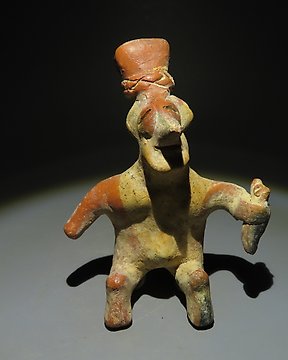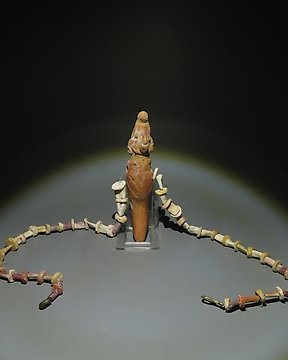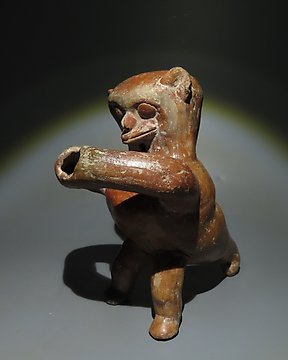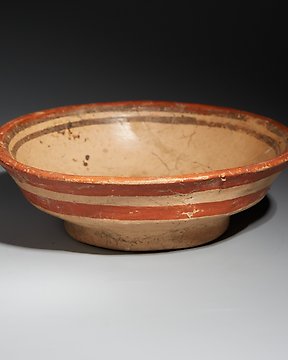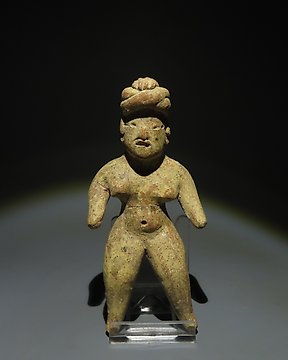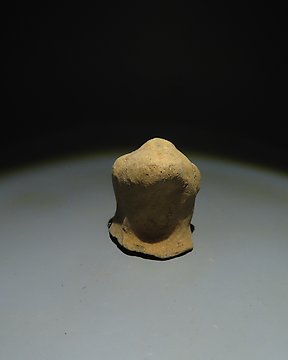Perfecto! :)
Zobacz tłumaczenieColima, zachodni Meksyk Terakota Postać antropomorficzna. 200 p.n.e. - 500 n.e. 17,5 cm H. Hiszpańska licencja eksportowa.
Nr 84860701


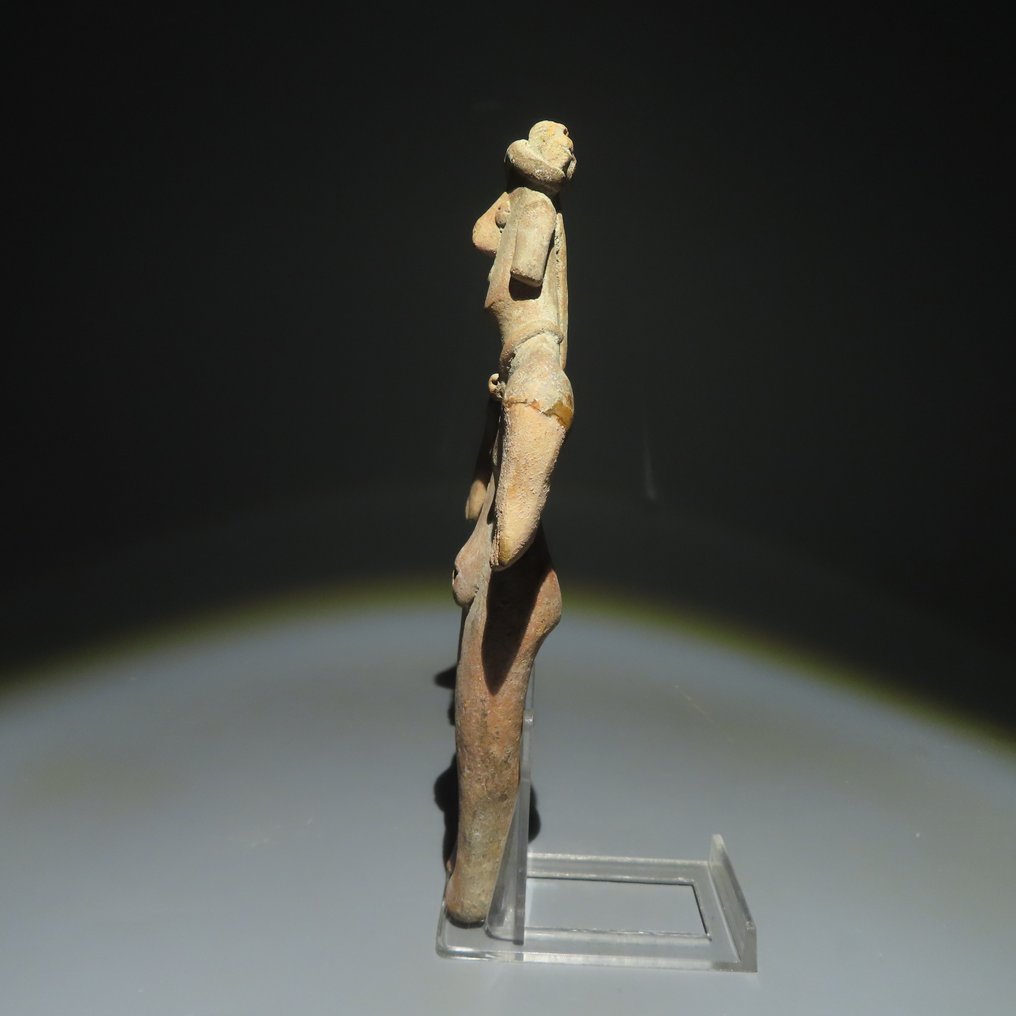
Anthropomorphic Figure.
CULTURE: Colima, Western Mexico
PERIOD: 200 BC - 500 AD
MATERIAL: Terracotta
DIMENSIONS: 17.5 cm H.
PROVENANCE: Private collection, Paris, France.
CONDITION: Good condition. The left arm is repaired from the original fragment. See photos.
DESCRIPTION:
The Colima people lived in northwest Mexico, in a rugged, low-lying coastal region carved by valleys, each with its own ecology and a warm, humid climate.
Little is known about their modes of subsistence, as most of the information we have comes from artifacts from private collections and from the excavation of cemeteries, not residential sites, which usually provide this kind of information. We do know that they practiced irrigation farming, which allowed them to live in large groups in relatively independent villages and urban centers.
Colima ceramics display a wide variety of figures and shapes, but little variation in technique. Most pieces have a burnished red finish and some are decorated with orange or white incisions. Molded figures are common, especially of plants, animals (especially dogs) and seashells. Human representations typically feature dwarfs and hunchbacks more than others, and few female forms. Many of these figures have “coffee-bean” eyes and are dressed in finely detailed traditional attire. Little is known of Colima stonework; only a few pieces such as mace heads, small masks and figurines have been found. These people also practiced basketweaving and weaving, and used metallurgy to make objects such as needles, axes, rattles, nose rings and ear ornaments.
Little is known about the Colima’s social order, but shamans or priests may have occupied positions of social importance. The existence of figurines resembling warriors as well as prisoners with hands tied points to the ceremonial importance of war in this pre-Columbian society.
The vast majority of ceramic pieces that have been ascribed to this culture are grave goods found in the tombs of individuals of high social rank. The Colima buried their dead in family tombs up to 30 meters deep, some with multiple chambers. The bodies were accompanied by a wide variety of grave goods, including ceramic statuettes of armed men, which served as symbolic guardians. Ceramic sculptures of dogs were another common grave good, and were believed to be the emissaries of Xolotl, the god of death.
The history of the Colima people is not well known, but, like many Mesoamerican cultures, the Colima displayed some stylistic elements that links them with the ancient Olmecs.
Notes:
- The piece includes authenticity certificate.
- The piece includes Spanish Export License.
- The seller guarantees that he acquired this piece according to all national and international laws related to the ownership of cultural property. Provenance statement seen by Catawiki.
Historie sprzedawców
Anthropomorphic Figure.
CULTURE: Colima, Western Mexico
PERIOD: 200 BC - 500 AD
MATERIAL: Terracotta
DIMENSIONS: 17.5 cm H.
PROVENANCE: Private collection, Paris, France.
CONDITION: Good condition. The left arm is repaired from the original fragment. See photos.
DESCRIPTION:
The Colima people lived in northwest Mexico, in a rugged, low-lying coastal region carved by valleys, each with its own ecology and a warm, humid climate.
Little is known about their modes of subsistence, as most of the information we have comes from artifacts from private collections and from the excavation of cemeteries, not residential sites, which usually provide this kind of information. We do know that they practiced irrigation farming, which allowed them to live in large groups in relatively independent villages and urban centers.
Colima ceramics display a wide variety of figures and shapes, but little variation in technique. Most pieces have a burnished red finish and some are decorated with orange or white incisions. Molded figures are common, especially of plants, animals (especially dogs) and seashells. Human representations typically feature dwarfs and hunchbacks more than others, and few female forms. Many of these figures have “coffee-bean” eyes and are dressed in finely detailed traditional attire. Little is known of Colima stonework; only a few pieces such as mace heads, small masks and figurines have been found. These people also practiced basketweaving and weaving, and used metallurgy to make objects such as needles, axes, rattles, nose rings and ear ornaments.
Little is known about the Colima’s social order, but shamans or priests may have occupied positions of social importance. The existence of figurines resembling warriors as well as prisoners with hands tied points to the ceremonial importance of war in this pre-Columbian society.
The vast majority of ceramic pieces that have been ascribed to this culture are grave goods found in the tombs of individuals of high social rank. The Colima buried their dead in family tombs up to 30 meters deep, some with multiple chambers. The bodies were accompanied by a wide variety of grave goods, including ceramic statuettes of armed men, which served as symbolic guardians. Ceramic sculptures of dogs were another common grave good, and were believed to be the emissaries of Xolotl, the god of death.
The history of the Colima people is not well known, but, like many Mesoamerican cultures, the Colima displayed some stylistic elements that links them with the ancient Olmecs.
Notes:
- The piece includes authenticity certificate.
- The piece includes Spanish Export License.
- The seller guarantees that he acquired this piece according to all national and international laws related to the ownership of cultural property. Provenance statement seen by Catawiki.
Historie sprzedawców
- 750
- 7
- 0
Wunderbares Stück. Alles wie beschrieben. Hervorragender Kontakt.
Zobacz tłumaczenieExtremely rapid courrier service from Barcelona to Flanders, picture was nicely and carefully packaged. Muchas gracias!
Zobacz tłumaczenieVery fine specimen! Thanks.
Zobacz tłumaczeniegoede foto's, goede omschrijving, goed verpakt en snel verzonden.
Zobacz tłumaczeniemolto bello tutto ok
Zobacz tłumaczeniePezzo come da descrizione, davvero notevole. Venditore molto consigliato in quanto gentile e disponibile. spedizione molto veloce. Ottimo!
Zobacz tłumaczenieVenditore davvero ottimo e gentile. Merce come da descrizione, spedizione veloce. Ottimo l'avere certificato di autenticità.
Zobacz tłumaczenieUn 100 como empresa un 100 como envío . Empresa muy especial con mucha exquisitez en todos los productos y en personal . Muchas gracias
Zobacz tłumaczenieAll well! Thanks.
Zobacz tłumaczenieVery nice and fine cut little jewel! Well packed too! Thanks!
Zobacz tłumaczenienice piece and very fast shipping!
Zobacz tłumaczenieEs una maravilla de moneda, donde se le nota los pasos de los años y me encanta. Servido muy rápido y bien empaquetado. Con su certificación. Qué más se puede pedir?
Zobacz tłumaczenieSnelle en correcte levering, alleen was de verpakking voor het schilderij niet stevig genoeg.
Zobacz tłumaczenieHerzlichen Dank!
Zobacz tłumaczenieAll OK and with very fast shipping.
Zobacz tłumaczeniePrachtig schilderij. Zo blij mee. Zeer nette verkoper en zeer snelle levering.
Zobacz tłumaczenieperfect ! very fast and high quality delivery !
Zobacz tłumaczenieAll well! Thanks.
Zobacz tłumaczenieVendeur très professionnel, top +++×
Zobacz tłumaczeniePhotos trop contrastées pour bien percevoir les défauts, mais ces défauts étaient visibles pour autant. Le "Bon état" est trompeur. Sinon, envoi rapide et correctement emballé. Frais de port exagérés.
Zobacz tłumaczenieGreat communication, delivery and product. Came with a well made certificate of authenticity and good packaging. Overall very happy with the purchase! Delivery is a bit expensive, but I recommend it
Zobacz tłumaczenieMagnifique témoin du passé, envoyé avec tous les justificatifs, impeccable. Encore une fois très satisfait, un grand merci
Zobacz tłumaczenieThank you for the Special offer and the fast shipping of this excellent piece of art!
Zobacz tłumaczenieKlauzula
Sprzedawca gwarantuje i może udowodnić, że przedmiot został nabyty legalnie. Sprzedawca został poinformowany przez firmę Catawiki, że musi dostarczyć dokumentację wymaganą przez przepisy ustawowe i wykonawcze obowiązujące w jego kraju zamieszkania. Sprzedawca gwarantuje i jest uprawniony do sprzedaży/eksportu tego przedmiotu. Sprzedawca przekaże nabywcy wszystkie znane informacje o pochodzeniu przedmiotu. Sprzedawca zapewnia, że wszelkie niezbędne pozwolenia są/zostaną załatwione. Sprzedawca niezwłocznie poinformuje nabywcę o wszelkich opóźnieniach w uzyskaniu takich zezwoleń.
Sprzedawca gwarantuje i może udowodnić, że przedmiot został nabyty legalnie. Sprzedawca został poinformowany przez firmę Catawiki, że musi dostarczyć dokumentację wymaganą przez przepisy ustawowe i wykonawcze obowiązujące w jego kraju zamieszkania. Sprzedawca gwarantuje i jest uprawniony do sprzedaży/eksportu tego przedmiotu. Sprzedawca przekaże nabywcy wszystkie znane informacje o pochodzeniu przedmiotu. Sprzedawca zapewnia, że wszelkie niezbędne pozwolenia są/zostaną załatwione. Sprzedawca niezwłocznie poinformuje nabywcę o wszelkich opóźnieniach w uzyskaniu takich zezwoleń.

